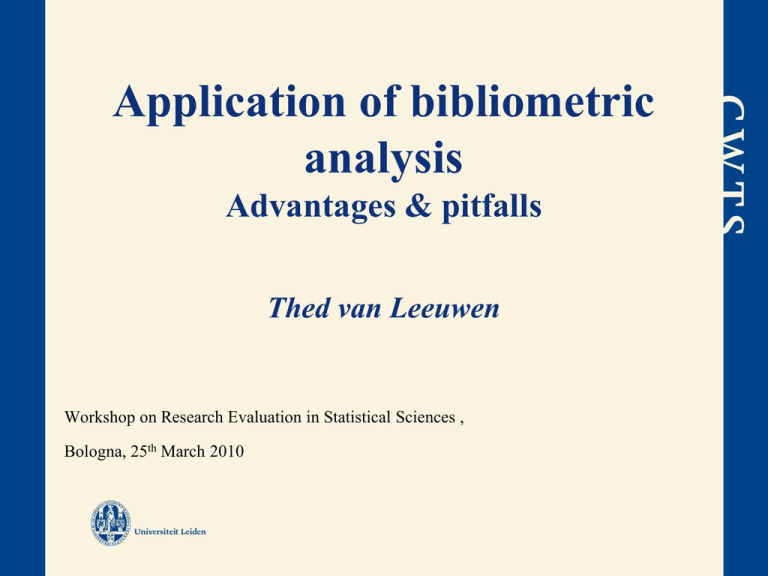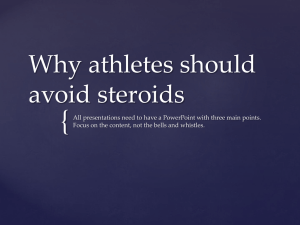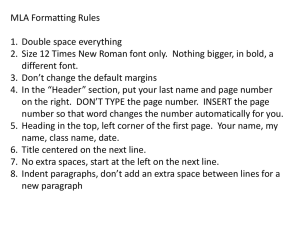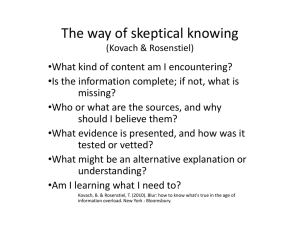Application of bibliometric analysis
advertisement

Application of bibliometric analysis Advantages & pitfalls Thed van Leeuwen Workshop on Research Evaluation in Statistical Sciences , Bologna, 25th March 2010 Introduction of bibliometrics • Bibliometrics can be defined as the quantitative analysis of science and technology performance and the cognitive and organizational structure of science and technology. • Basic for these analyses is the scientific communication between scientists through (mainly) journal publications. • Key concepts in bibliometrics are output and impact, as measured through publications and citations. • Important starting point in bibliometrics: scientists express, through citations in their scientific publications, a certain degree of influence of others on their own work. • By large scale quantification, citations indicate influence or (inter)national visibility of scientific activity, but should not be interpreted as synonym for ‘quality’. CWTS data system • CWTS has a full bibliometric license from Thomson Reuters Scientific to conduct evaluation studies using the Web of Science. • Our database covers the period 1981-2009. • Some characteristics: – – – – Over 31.000.000 publications. Over 350.000.000 citation relations between source papers. 100.000.000 authors (incl. variations), 15.000.000 ‘unique’ names. Over 60.000.000 addresses, some 90% cleaned up over the last 10 years. – Contains reference sets for journal and field citation data. Bibliometric indicators produced by CWTS Some basic indicators are … • P: number of publications in journals processed for the Web of Science. • C: number of received citations, excl. self-citations. • CPP: mean number of citations per publication, excl. self- citations • Pnc: percentage of the publications not cited (within a certain time-frame !!!) • % SC: percentage self-citations related to an output set. Important indicators are… • CPP/JCSm: ratio between real, actual impact, and mean journal impact. • CPP/FCSm: ratio between real, actual impact, and mean field impact. • JCSm/FCSm: ratio between journal impact, and field impact, indicative for the ‘quality’ of the journal package in the field Various types of analysis focus on … • Research profiles: a break down of the output over various fields of science. • Scientific cooperation analysis: a break down of the output over various types of scientific collaboration. • Knowledge user analysis: a break down of the ‘responding’ output into citing fields, countries or institutions. • Highly cited paper analysis: which publications are among the most highly cited output (top 10%, 5%, 1%) of the global literature in that same field(s). • Social network analysis: how is the network of partners composed, based on scientific cooperation. Journal & Field Normalization Calculating the JCSm & FCSm ---------------------------------------------------------------------------------------------Type publ. Journal year Journal category # citations until 1999 ---------------------------------------------------------------------------------------------I review 1996 II note1997 III article 1999 J CLIN END Endocrinology 6 IV article 1999 J CLIN END Endocrinology 8 CANCER RES J CLIN END Oncology Endocrinology 17 4 ---------------------------------------------------------------------------------------------- Calculating the JCSm & FCSm 2 ----------------------------------------------------------------- CPP JCS FCS ----------------------------------------------------------------- I 17 16.9 23.7 II 4 3.1 3.0 III 6 4.8 4.1 IV 8 4.8 4.1 ----------------------------------------------------------------- Calculating the JCSm & FCSm 3 The mean citation score is determined as: 17 + 4 + 6 + 8 CPP = ------------------ = 8.8 1+1+1+1 The mean journal citation score as: (1 x 16.9) + (1 x 3.1) + (2 x 4.8) JCSm = -------------------------------------- = 7.4 1+1+2 The mean field citation score as: (1 x 23.7) + (1 x 3.0) + (2 x 4.1) FCSm = -------------------------------------- = 8.7 1+1+2 CPP / JCSm (8.8 / 7.4) = 1.19 CPP / FCSm (8.8 / 8.7) = 1.01 Citation Windows & Impact Measurement Citation measurement and ‘windows’ • Publication years, fixed citation ‘window’. Publications of 2002, with three citation years (namely 2002, 2003, and 2004), followed by 2003, with three years, etc. • Blocks of publication years with a window decreasing in length. Publications of 2002-2005, with citation window of 4 years (2002-2005), 3 years (2003-2005), 2 years (2004-2005), and 1 year (2005). Citation measurement with ‘fixed window’ Citation years 2002 2003 2004 2005 2006 2007 2008 2009 2002 2003 2004 2005 2006 2007 2008 2009 2002 2003 2004 2003 2004 2005 2004 2005 2006 2005 2006 2007 2006 2007 2008 2007 2008 2009 2008 2009 2009 Citation measurement with ‘year blocks’ Citation years 2002 2003 2004 2005 2006 2007 2008 2009 2002 2003 2004 2005 2002 2003 2003 2003 2004 2004 2004 2004 2004 2005 2005 2005 2005 2005 2005 2005 2005 2005 2006 2006 2006 2006 2006 2006 2006 2006 2007 2007 2007 2007 2007 2007 2007 2007 2007 2007 2008 2008 2008 2008 2008 2008 2008 2008 2009 2009 2009 2009 2009 Methodological issues Adequacy of citation indexes : implications for bibliometric studies How to tackle this issue ? • We conduct analyses on the adequacy of the citation indexes across disciplines based on reference behavior of researchers themselves. • The degree of referring towards other indexed literature indicates the importance of journal literature in the scientific communication process. Assessment of WoS Coverage Citing/Source NonWoS WoS Non-Wos Journals Books ?% ?% Conference proceedings Reports Cited/Target NonWoS WoS Etc. Total ISI/WoS Database (2002) Citing/Source NonWoS 25% Cited/Target NonWoS WoS 75% WoS The medical & Life sciences 100% Ref erences non-ISI Ref erences ISI 90% 80% 70% 60% 50% 40% 30% 20% 10% AGRICULTURE AND FOOD SCIENCE BASIC LIFE SCIENCES BASIC MEDICAL SCIENCES BIOLOGICAL SCIENCES BIOMEDICAL SCIENCES CLINICAL MEDICINE HEALTH SCIENCES 2006 2001 1996 1991 2006 2001 1996 1991 2006 2001 1996 1991 2006 2001 1996 1991 2006 2001 1996 1991 2006 2001 1996 1991 2006 2001 1996 1991 0% The natural sciences 100% Ref erences non-ISI Ref erences ISI 90% 80% 70% 60% 50% 40% 30% 20% 10% ASTRONOMY CHEMISTRY AND AND ASTROPHYSICS CHEMICAL ENGINEERING COMPUTER SCIENCES EARTH ENVIRONMENTALMATHEMATICS PHYSICS AND SCIENCES SCIENCES AND MATERIALS AND TECHNOLOGY SCIENCE TECHNOLOGY 2006 2001 1996 1991 2006 2001 1996 1991 2006 2001 1996 1991 2006 2001 1996 1991 2006 2001 1996 1991 2006 2001 1996 1991 2006 2001 1996 1991 2006 2001 1996 1991 0% STATISTICAL SCIENCES Statistical sciences 0% 10% 20% 30% 40% 50% 60% 70% 80% 90% 100% 1991 1996 References ISI References non-ISI 2001 2006 The engineering sciences 100% Ref erences non-ISI 90% Ref erences ISI 80% 70% 60% 50% 40% 30% 20% 10% 0% 1991 1996 2001 2006 1991 1996 2001 2006 1991 1996 2001 2006 1991 1996 2001 2006 1991 1996 2001 2006 1991 1996 2001 2006 CIVIL ENGINEERING ELECTRICAL ENERGY SCIENCE AND ENGINEERING AND AND TECHNOLOGY CONSTRUCTION TELECOMMUNICATION GENERAL AND INDUSTRIAL ENGINEERING INSTRUMENTS AND MECHANICAL INSTRUMENTATION ENGINEERING AND AEROSPACE The social– and behavioral sciences 100% Ref erences non-ISI Ref erences ISI 90% 80% 70% 60% 50% 40% 30% 20% 10% 2006 2001 1996 1991 2006 2001 1996 1991 2006 2001 1996 1991 2006 2001 1996 1991 2006 2001 1996 1991 2006 2001 1996 1991 2006 2001 1996 1991 0% ECONOMICS EDUCATIONAL MANAGEMENT POLITICAL PSYCHOLOGY SOCIAL AND SOCIOLOGY AND AND BUSINESS SCIENCES AND PLANNING SCIENCE AND BEHAVIORAL ANTHROPOLOGY PUBLIC SCIENCES, ADMINISTRATION INTERDISCIPLINARY The humanities 100% References non-ISI References ISI 90% 80% 70% 60% 50% 40% 30% 20% 10% INFORMATION AND COMMUNICATION SCIENCES LANGUAGE AND LINGUISTICS CREATIVE ARTS, CULTURE AND MUSIC HISTORY, PHILOSOPHY AND RELIGION LAW AND CRIMINOLOGY LITERATURE 2006 2001 1996 1991 2006 2001 1996 1991 2006 2001 1996 1991 2006 2001 1996 1991 2006 2001 1996 1991 2006 2001 1996 1991 0% Overall WoS coverage by main field EXCELLENT (> 80%) VERY GOOD (60-80%) GOOD(40-60%) Biochem & Mol Biol Appl Phys & Chem Mathematics & Statistical sciences Biol Sci – Humans Biol Sci – Anim & Plants Economics Chemistry Psychol & Psychiat Engineering Clin Medicine Geosciences MODERATE (<40 %) Phys & Astron Soc Sci ~ Medicine Other Soc Sci Humanities & Arts Conclusions on adequacy issue • We can clearly conclude that the application of bibliometric techniques, solely based on WoS (but very likely also Scopus) will not be valid for some of the ‘soft’ fields in the social sciences and the humanities. • That is why the tool box has to be extended ! The H-Index and its limitations The H-Index, defined as … • The H-Index is the score that indicates the position at which a publication in a set, the number of received citations is equal to the ranking position of that publication. • Idea of an American physicist, J. Hirsch, who published about this index in the Proc. NAS USA. Examples of Hirsch-index values 350 • Environmental biologist, output of 188 papers, cited 4,788 times in the period 80-04. 300 250 200 Citations 150 • Hirsch-index value of 31 Value of H-Index= 31 100 50 0 0 20 40 60 80 100 120 140 160 180 200 Publications 80 • Clinical psychologist, output of 72 papers, cited 760 time sin the period 80-04. 70 60 50 Citations 40 • Hirsch-index value of 14 30 Value of H-Index= 14 20 10 0 0 10 20 30 40 Publications 50 60 70 80 Problems with the H-Index • For serious evaluation of scientific performance, the H-Index is as indicator not suitable, as the index: – Is insensitive to field specific characteristics (e.g., difference in citation cultures between medicine and other disciplines). – Does not take into account age and career length of scientists, a small oeuvre leads necessarily to a low H-Index value. – Is inconsistent in its ‘behaviour’. 7.00 • Actual versus field normalized impact (CPP/FCSm) displayed against the output. 6.00 Phy 5.00 CPP/FCSm 4.00 Phy Soc Med Psy Med 3.00 Eng Med Eng Soc Med 2.00 Hum Mat Che Psy Phy Env Bio Psy Che Bio Med Bio Phy Med Med 1.00 0.00 0 50 100 150 TOTAL PUBLICATIONS 200 250 • Large output can be combined with a relatively low impact 60 • H-Index displayed against the output. Med 50 Med 40 H-index Bio Med Phy 30 Env Phy Psy Bio Bio Med Med Med Che Psy Che Phy 20 Med Eng Soc Mat Hum Soc 10 Phy Eng Psy 0 0 50 100 150 TOTAL PUBLICATIONS 200 250 • Larger output is strongly correlated with a high HIndex value. Consistency: Definition Definition. A scientific performance measure is said to be consistent if and only if for any two actors A and B and for any number n ≥ 0 the ranking of A and B given by the performance measure does not change when A and B both have a new publication with n citations. 35 Consistency: Motivation • Consistency ensures that if the publishing behavior of two actors does not change over time, their ranking relative to each other also does not change • Consistency ensures that if the individual researchers in one research group X outperform the individual researchers in another research group Y, the former research group X as a whole outperforms the latter research group Y. 36 Inconsistency of the h-index 9 8 8 7 7 6 6 5 h=4 4 citations 9 5 3 2 2 1 1 0 2 4 6 8 publications 10 0 12 9 9 8 8 7 7 6 6 5 h=8 4 2 2 1 1 2 4 6 8 publications 10 12 2 4 6 8 publications 10 12 h=6 4 3 0 0 5 3 0 h=6 4 3 0 citations Actor B citations citations Actor A 0 0 2 4 6 8 publications 10 12 37 ISI Impact Factors: calculation and validity Methodology: ISI’s classical IF • The ISI Impact Factor (IF) is defined as the number of citations received by a journal in year t, divided by the number of citeable documents in that same journal in the years t-1 and t-2, • Or, as a Formula: Citations in year t Number of ‘citeable documents’ in t-1 & t-2 Share ‘citations-for-free’ for The Lancet Publications Citations 90+91 1992 Article 784 2986 Note 144 593 29 232 Review Sub-total Letter 957 (a) 4181 (d) 7959 (b) 4264 (e) Editorial 1313 905 Other 1421 909 Total 7872 14037 (c) • ISI Method: Citations in 2000 . Citeable documents in ‘98 and ‘99 14037 957 (c) (a) IF=14.7 • CWTS Method: Citations to Art/Not/Rev in 2000 Art/Not/Rev in ‘98 and ‘99 7959 957 (b) (a) . IF=8.3 Citations to Art/Let/Not/Rev in 2000 . Art/Let/Not/Rev in ‘98 and ‘99 7959+4264 957+4181 (b+e) (a+d) IF=2.4 ISI Impact Factors • From 1995 onwards CWTS has analyzed the uses and validity ISI Journal Impact Factor (IF). • Most important points of criticism were: – Calculated erroneously. – Not sensitive for the composition of the journal in terms of the document types. – Not sensitive for the science fields a journal is attached to … – Based on too short ‘citation windows’. Distribution of citations used for the calculationof the IF value of The Lancet • The red area indicates citations ‘for free’, while the blue area indicates ‘correct citations’ 100% 90% 80% 70% 60% 50% • The IF-score of The Lancet is seriously ‘overrated’ by the scientific ‘audience’ of the journal. 40% 30% 20% 10% 0% 82 83 84 85 86 87 88 89 90 91 92 93 94 95 96 97 98 Impact Factors for Br. J. Clin. Pharm. and Clin. Pharm. & Ther. 4.50 • The graph shows the correct and erroneous impact factors of BJCP and CPT 4.00 3.50 3.00 CPT Err IF CPT IF BJCP Err IF BJCP IF • In the case of CPT, citations to published meeting abstracts are included, while BJCP has stopped publishing of meeting abstracts ! 2.50 2.00 1.50 1.00 0.50 0.00 83 84 85 86 87 88 89 90 91 92 93 94 95 96 97 98 Document types and fields Field Journal IF JFIS IMMUNOLOGY ANN REV IMMUNOL 50.49 1 5.18 1 BIOCHEM & MOLECULAR BIOL ANN REV BIOCHEM 34.61 1 4.10 3 PHARMACOL & PHARMACY PHARMACOLOGICAL REV 27.74 1 4.75 1 CELL BIOL ANN REV CELL & DEVELOPM BIOL 27.53 1 1.72 13 DEVELOPMENTAL BIOL ANN REV CELL & DEVELOPM BIOL 27.53 1 1.72 3 PHYSIOLOGY PHYSIOLOGICAL REV 24.82 1 3.18 1 CELL BIOLOGY NATURE REV MOL CELL BIOL 22.21 4 2.76 8 ENDOCRINOL & METABOLISM ENDOCRINE REV 21.98 1 2.87 1 NEUROSCIENCES ANN REV NEUROSCIENCE 21.89 1 3.12 4 PHYSICS REV MODERN PHYSICS 20.14 1 5.02 1 CHEMISTRY CHEMICAL REV 19.67 1 2.89 2 The IF is for ‘02, JFIS covers ‘98-‘02 Fields and Citation windows Phsyics Engineering sciences Chemistry 0 POLYMER SCIENCE (55) CHEM, APPLIED (25) CHEM, CLIN&MEDIC (8) CHEM, PHYSICAL (78) CRYSTALLOGRAPHY (18) ELECTROCHEMISTRY (10) CHEM, INORG&NUC (37) BIOCH & MOL BIOL (169) CHEM, ORGANIC (42) CHEMISTRY (128) CHEM, MISCELLAN (7) CHEM, ANALYTICAL (54) ENG, INDUSTRIAL (14) ENG, MANUFACT (5) ENGINEERING (84) ENG, BIOMEDICAL (33) ENG, PETROLEUM (8) ENG, MECHANIC (69) ENG, CIVIL (49) ENG, ENVIRONM (6) ENG, CHEMICAL (69) ENG, MARINE (8) ENG, ELECTRICAL (127) PHYSICS, MATHEMA (10) ACOUSTICS (20) THERMODYNAMICS (11) PHYSICS, FLUIDS (16) PHYSICS, MISCELL (6) PHYSICS, AT,M,C (22) OPTICS (37) PHYSICS, APPLIED (49) PHYSICS, COND MA (36) PHYSICS (85) PHYSICS, NUCLEAR (16) PHYSICS, PART&FI (11) 0.5 1 1.5 2 2.5 3 3.5 4 4.5 Citation measurement of IF 2002 2003 2004 2005 2006 2007 2008 2009 2002 2003 2004 2005 2006 2007 2008 2009 2002 2003 2004 2003 2004 2005 2004 2005 2006 2005 2006 2007 2006 2007 2008 2007 2008 2009 2008 2009 2009 CWTS answer to the problems of the IF • This indicator is the JFIS, the Journal-to-Field Impact Score. • The JFIS solves the main objections against the Impact Factor, as – the calculation of JFIS is based on equally large entities, – document types are taken into account, – JFIS is field-normalized, and finally, – based on longer citation windows (1-4 years) Citation measurement of JFIS Citation years 2002 2003 2004 2005 2006 2007 2008 2009 2002 2003 2004 2005 2002 2003 2003 2003 2004 2004 2004 2004 2004 2005 2005 2005 2005 2005 2005 2005 2005 2005 2006 2006 2006 2006 2006 2006 2006 2006 2007 2007 2007 2007 2007 2007 2007 2007 2007 2007 2008 2008 2008 2008 2008 2008 2008 2008 2009 2009 2009 2009 2009 End of the presentation For questions regarding the contents of the presentation, mail to: leeuwen@cwts.nl






